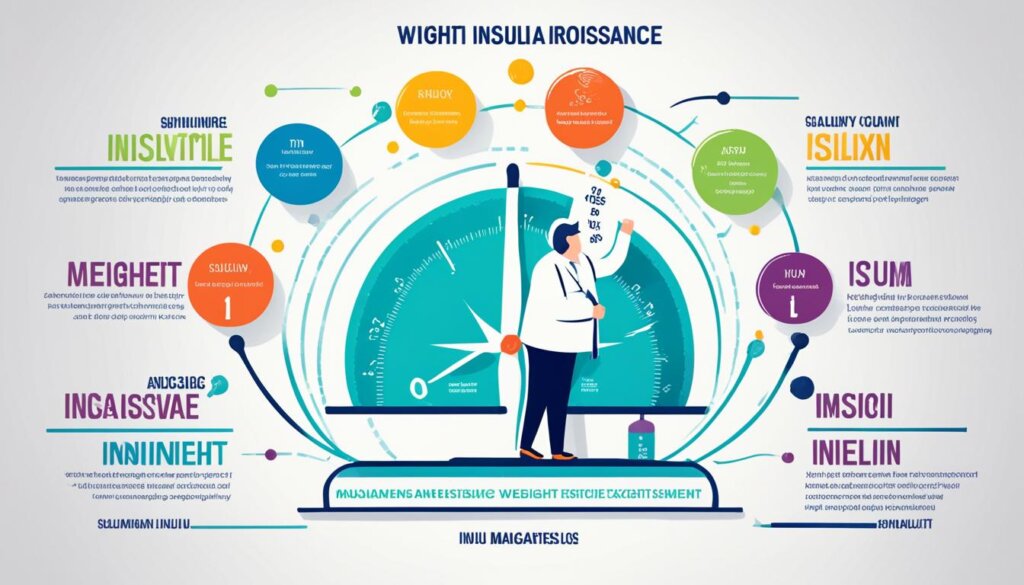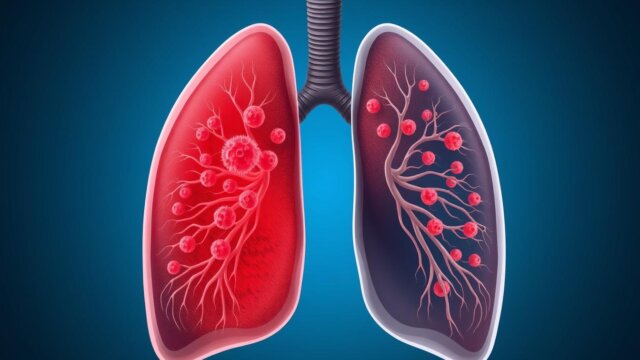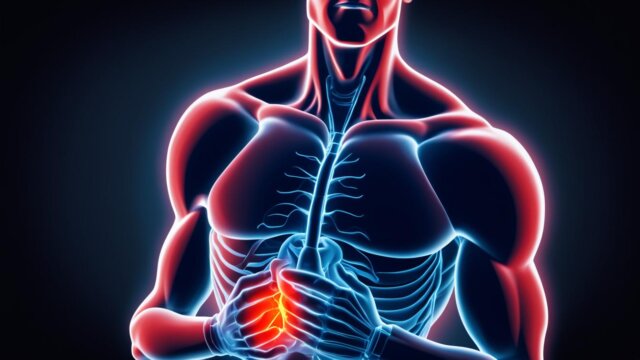FTC disclaimer: This post may contains affiliate links and we will be compensated if you click on a link and make a purchase.
Did you know that over 84 million adults in the U.S. have prediabetes? This means about 1 in 3 adults are affected. This shows how common insulin resistance is. It happens when your cells don’t react to insulin well. Insulin is key for controlling blood sugar levels.
Knowing about insulin resistance’s causes, signs, and how to manage it is key. It helps keep your metabolism healthy and stops type 2 diabetes.
Key Takeaways
- Insulin resistance makes your cells less responsive to insulin. This can lead to prediabetes and type 2 diabetes if not treated.
- Being overweight, not being active, and some health issues like metabolic syndrome cause insulin resistance.
- Blood tests and screenings can spot insulin resistance early. This helps stop it from getting worse.
- Changing your lifestyle through diet, exercise, and managing weight can prevent or fix insulin resistance.
- Doctors might prescribe medicines like metformin for some people with insulin resistance.
What is Insulin Resistance?
Definition and Process
Insulin resistance means your muscles, fat, and liver don’t react right to insulin. Normally, insulin lets glucose, your main energy source, into your cells. But with insulin resistance, your cells ignore insulin’s signal. This makes glucose build up in your blood instead of being used.
Your pancreas then makes more insulin to keep blood glucose levels normal. This leads to high insulin levels in your body.
Insulin resistance can lead to serious health issues like type 2 diabetes, metabolic syndrome, and heart disease. It’s important to know how to prevent and manage it to stay healthy.
Insulin Resistance Prevalence | Percentage |
|---|---|
Prevalence among adults worldwide | 15.5% to 46.5% |
Adults globally affected by type 2 diabetes | More than 9% |
Many things can cause insulin resistance, like your lifestyle, genes, and health conditions. To manage it, you can try diet, exercise, and sometimes medicine.
“Insulin resistance is a key component of metabolic syndrome and a major risk factor for the development of type 2 diabetes and cardiovascular disease.”
Insulin Resistance vs. Diabetes
Insulin resistance and diabetes are related but different. Insulin resistance happens when your cells don’t react to insulin well. This leads to high insulin levels in your blood. Prediabetes is when your blood sugar is higher than normal but not high enough for type 2 diabetes. If not managed, insulin resistance can turn into prediabetes and then type 2 diabetes.
Type 1 diabetes is an autoimmune disease where your body attacks the cells that make insulin. Gestational diabetes is a temporary condition that can happen during pregnancy. Insulin resistance is a big part of type 2 diabetes, but it’s not the only cause.
Condition | Definition | Causes | Risk Factors |
|---|---|---|---|
Insulin Resistance | Cells don’t respond well to insulin, leading to high insulin levels | Excess weight, inactivity, genetics | Obesity, family history, high blood sugar, high triglycerides, low HDL cholesterol |
Prediabetes | Blood glucose levels higher than normal, but not high enough for type 2 diabetes | Insulin resistance, lifestyle factors | Overweight, family history, physical inactivity |
Type 1 Diabetes | Autoimmune condition where the body attacks insulin-producing cells | Autoimmune response, genetics | Family history, certain genetic factors |
Type 2 Diabetes | Body doesn’t use insulin effectively, leading to high blood sugar | Insulin resistance, lifestyle factors, genetics | Obesity, family history, physical inactivity, unhealthy diet |
Gestational Diabetes | High blood sugar during pregnancy | Hormonal changes, weight gain, family history | Overweight, family history, previous gestational diabetes |
Insulin resistance and diabetes are connected but have their own traits. Knowing the differences helps people manage their health better.
Causes of Insulin Resistance
Insulin resistance is caused by many things, like your lifestyle, genes, and health. Key causes are excess body weight, especially around the belly, and not moving enough. Eating too many refined carbs and bad fats also plays a part.
Risk Factors and Contributors
Some things you can’t change make you more likely to get insulin resistance. These include having a family history of diabetes, being older, and being from certain ethnic groups. Having PCOS, fatty liver disease, or metabolic syndrome also raises your risk. Some medicines, hormonal issues, and sleep problems can also make it worse.
Risk Factor | Description |
|---|---|
Obesity | Having too much weight, especially around the belly, is a big reason for insulin resistance. |
Inactivity | Not moving much and sitting a lot can make insulin resistance worse. |
Diet | Eating too many refined carbs and bad fats can lead to insulin resistance. |
Family History | If diabetes runs in your family, you’re more likely to get insulin resistance. |
Age | As you get older, you’re more likely to have insulin resistance. |
Ethnicity | Some groups, like Asian, Hispanic, and African American, face a higher risk of insulin resistance. |
Changing your lifestyle, using medicine, and managing health conditions can help prevent or control insulin resistance. Exercise, losing weight, and eating well can make your body more sensitive to insulin and lower the risk of problems.
Symptoms of Insulin Resistance
Insulin resistance often has no clear signs early on. Some people may develop darkened skin in the armpits, neck, or other areas, a condition called acanthosis nigricans. Small skin growths called skin tags may also appear in these areas.
Many people with insulin resistance don’t know they have it until they get prediabetes or type 2 diabetes and get blood tests. The effects of insulin resistance – like high blood pressure, high triglycerides, and low HDL (“good”) cholesterol – can also go unnoticed without regular check-ups.
A hemoglobin A1C result between 5.7% and 6.4% can indicate insulin resistance and prediabetes. An A1C result of 6.5% or higher suggests a diagnosis of type 2 diabetes. High cholesterol levels, including elevated triglycerides, increased LDL cholesterol, and decreased HDL cholesterol, may be signs of insulin resistance.
- Tingling in the feet may be a symptom of neuropathy linked to high blood sugar levels.
- Children with insulin resistance might develop patches of thickened, darkened, or velvety skin in areas such as the neck and armpits.
Staying active and eating well is key for managing insulin resistance in kids.
“Around 1 in 3 people in the United States have prediabetes, and over 85% of people with prediabetes are likely unaware of their condition.”
Up to 50% of people with prediabetes can prevent diabetes through lifestyle changes. Losing 5–7% of body weight for those who are overweight or obese can lower the risk of diabetes. The Department of Health and Human Services suggests testing everyone over 45 for diabetes and those under 45 with risk factors.

High blood pressure is linked to a higher risk of insulin resistance.
40% of adults between 18 and 44 have insulin resistance, which can lead to type 2 diabetes. Half of adults with insulin resistance are not obese by weight standards. Studies show people with insulin resistance may have poorer brain function than those without it.
Insulin resistance causes high blood sugar, leading to increased hunger as a symptom. According to studies, many processed foods are high in calories and can lead to overeating and weight gain. Eating foods high in fiber can help keep blood sugar stable. Foods like beans, spinach, almonds, pumpkin seeds, cashews, and avocados are good for fighting insulin resistance.
Regular exercise can make insulin work better, helping to manage or reverse insulin resistance, says the American Diabetes Association. Health issues like high blood sugar, high LDL (“bad”) cholesterol, low HDL (“good”) cholesterol, and high triglycerides may show insulin resistance. Risk factors include a family history of type 2 diabetes, being overweight or obese, and a sedentary lifestyle.
Diagnosing Insulin Resistance
Blood Tests and Screening
To see if you have insulin resistance, you’ll need blood tests and screenings. There’s no one test that can tell you for sure. Doctors use several blood tests to check how well your body uses insulin and look for prediabetes, which can lead to type 2 diabetes.
Some tests used to find insulin resistance include:
- Fasting plasma glucose test
- Oral glucose tolerance test
- Hemoglobin A1c (HbA1c)
- Lipid panel to check cholesterol and triglyceride levels
If your blood sugar is higher than normal but not high enough for diabetes, you might have prediabetes. This means you could be at risk of insulin resistance. Doctors suggest screening for insulin resistance if you’re 35 or older, or if you’re overweight or have a family history of diabetes.
The European Group for the Study of Insulin Resistance says insulin resistance is when your body doesn’t use insulin well. They use a special test called the hyperinsulinemic-euglycemic clamp to check this.
What’s normal for insulin sensitivity depends on your weight. For people who are not overweight, it’s usually between 0.026 to 0.085 mmol/L/minute. For those who are obese, it’s lower, from 0.012 to 0.017 mmol/L/minute.
Understanding insulin resistance and the tests for it can help you and your doctor manage it better.
Insulin Resistance and Metabolic Syndrome
Insulin resistance is a big part of metabolic syndrome. This is a group of health issues that raise the risk of heart disease, stroke, and type 2 diabetes. To get metabolic syndrome, you need to have at least three of these health issues: high blood sugar, high triglycerides, low HDL (“good”) cholesterol, high blood pressure, and a big waist. This shows why fighting insulin resistance is key to handling metabolic syndrome.
Insulin resistance means your cells don’t react well to insulin. This leads to problems like high triglycerides, low HDL cholesterol, and high blood pressure. Changing your lifestyle, like eating right, exercising, and keeping a healthy weight, can help fix these issues.
About one-third of U.S. adults have metabolic syndrome. Hispanics, especially Hispanic women, are at a higher risk. By changing your lifestyle to fight insulin resistance, you can lower the risk of serious health problems like type 2 diabetes and heart disease.
Metabolic Syndrome Criteria | Threshold Values |
|---|---|
Waist Circumference | More than 35 inches for women, more than 40 inches for men |
Blood Pressure | 130/80 mm Hg or higher |
Fasting Blood Glucose | 100 mg/dL or greater |
Triglycerides | 150 mg/dL or higher |
HDL Cholesterol | Less than 40 mg/dL for men, less than 50 mg/dL for women |
Knowing how insulin resistance and metabolic syndrome are linked helps people take action. Keeping a healthy lifestyle, like staying active, eating well, and keeping a healthy weight, is key to preventing and managing metabolic syndrome.
“The American Heart Association forecasts that metabolic syndrome may soon become the main risk factor for cardiovascular disease.”
Lifestyle Modifications for Managing Insulin Resistance
Changing your lifestyle is key to managing insulin resistance and stopping it from turning into diabetes. This means eating a healthy diet, staying active, and losing weight if you’re heavy.
Diet, Exercise, and Weight Management
Eat less bad fat, sugar, meat, and processed carbs. Eat more veggies, fruits, whole grains, fish, and lean chicken. Eating over 50 grams of fiber a day helps keep your blood sugar stable. Drinking low-fat milk and plain nonfat yogurt can also help.
Exercise for half an hour, 3–5 times a week, makes your body more sensitive to insulin. This effect can last even after eight weeks of regular workouts. Resistance training helps both men and women, with or without diabetes. Not sleeping well can make you less sensitive to insulin, so getting enough sleep is key. Stress can also lower your insulin sensitivity, so managing stress is important.
Food with added sugar, fat, and salt can make insulin resistance worse. Foods high in saturated and trans fats, like meat and cheese, also increase insulin resistance. Drinks with sugar, like soda and fruit juices, can lead to weight gain and insulin resistance.
The National Diabetes Prevention Program shows that these lifestyle changes can really help prevent diabetes. Doctors might also prescribe medicine like metformin for those at high risk of getting diabetes.
Medications for Treating Insulin Resistance
There is no single drug to “cure” insulin resistance. But, some drugs can help manage its effects and lower the risk of type 2 diabetes. Metformin is often given to those with prediabetes or at high risk of getting type 2 diabetes. It makes the body more sensitive to insulin and lowers glucose in the liver.
But, metformin can cause side effects like diarrhea, nausea, vomiting, and belly pain. These usually go away as the body gets used to the drug. A rare but serious side effect is lactic acidosis, which can cause cramps, nausea, weakness, and fast breathing.
Other drugs, like those for high blood pressure, high cholesterol, or PCOS, can also help with insulin resistance. Pioglitazone (Actos) starts at a low dose of about 15 mg a day and can go up to 30 or 45 mg. Rosiglitazone (Avandia) comes in 4-mg or 8-mg tablets, taken once a day or twice. But, these drugs can cause swelling, weight gain, and increase the risk of heart failure and fractures.
Lifestyle changes are key to managing insulin resistance. Being overweight is linked to insulin resistance and heart disease, and inflammation also plays a part in it. Eating well, exercising regularly, and keeping a healthy weight can greatly improve insulin sensitivity and lower health risks.

Insulin Resistance and Polycystic Ovary Syndrome (PCOS)
Insulin resistance is closely tied to polycystic ovary syndrome (PCOS). This hormonal disorder affects up to 15% of women who can have babies. Most people with PCOS also have insulin resistance. This can cause symptoms like irregular periods, acne, and trouble getting pregnant.
The Link Between PCOS and Insulin Resistance
Researchers are still figuring out how PCOS and insulin resistance are connected. Genetics, being overweight, and high androgen levels might play a part. PCOS can start as early as age 11 or 12 and might not be diagnosed until later, when trying to conceive. Symptoms include acne, hair growth, dark skin in folds, irregular periods, and weight gain.
Many studies look at how PCOS, insulin resistance, and treatments are linked. These studies show that PCOS patients often have trouble with glucose levels during puberty. Nutrition therapy and certain medicines can help improve health in overweight women with PCOS. Exercise also helps with insulin resistance in PCOS. Eating a Mediterranean-style diet might be good for women with PCOS too.
Managing insulin resistance with lifestyle changes and sometimes medicine is key to handling PCOS. Knowing how these conditions are linked helps doctors help people with PCOS reach their health and fertility goals.
In summary, the strong link between insulin resistance and PCOS shows the need to tackle insulin issues in managing this complex hormonal disorder. With a full approach that includes lifestyle changes, specific treatments, and regular doctor visits, people with PCOS can improve their health. This can help them overcome infertility and other metabolic problems.
Insulin Resistance and Pregnancy
Insulin resistance can affect pregnancy, leading to gestational diabetes. This happens when the body doesn’t use insulin well during pregnancy. Women with insulin resistance before pregnancy face a higher risk of getting gestational diabetes.
Insulin resistance can cause high blood pressure and make the baby grow too big. To manage these risks, pregnant people with insulin resistance or gestational diabetes need to watch their blood sugar closely. They can do this through diet, exercise, and sometimes medicine.
About 3 to 9 out of 100 pregnant people get gestational diabetes. Type 2 diabetes, especially in overweight people, raises the risk of getting gestational diabetes. Carrying twins or more can also increase this risk.
All pregnant people without diabetes get tested for gestational diabetes between 24 and 28 weeks. Treatment includes a special diet, exercise, checking blood sugar, insulin shots, and medicine for low blood sugar.
Not treating insulin resistance and gestational diabetes can be serious. Women with gestational diabetes might get type 2 diabetes later. Babies of people with diabetes could have serious health problems, including stillbirth.
Babies born to people with diabetes might be too big or have low blood sugar after birth. They could also have trouble breathing if born too early. People with diabetes are also at risk of preeclampsia, a serious pregnancy complication.
Women with type 1 diabetes need more insulin during pregnancy, but the need changes over time. Pregnancy affects insulin needs differently in type 1 and type 2 diabetes. Being overweight can lead to bad pregnancy outcomes and obesity in the baby.
Studies looked into how pregnancy affects the placenta in obese and diabetic mothers. They found that a hormone called placental growth hormone changes during pregnancy.

Complications of Untreated Insulin Resistance
Insulin resistance is a serious condition. If not managed, it can lead to many health problems. Without action, it often turns into prediabetes and then type 2 diabetes. But the risks of insulin resistance go beyond diabetes.
Those with insulin resistance might feel very thirsty, need to pee a lot, see blurry, or feel very tired. Too much fat from not moving can make insulin and glucose issues worse. This can lead to liver disease, high triglycerides, high LDL (“bad”) cholesterol, and heart disease.
Untreated insulin resistance doesn’t just stop there. It can raise the risk of some cancers and Alzheimer’s disease. It’s also linked to eye problems and other diabetic issues.
The good news is, that managing insulin resistance early can prevent these serious problems. Making lifestyle changes and sometimes taking medicine can help. Early action is key to better health and avoiding insulin resistance complications.
“Insulin resistance is a silent killer that can lead to a range of debilitating health issues if left unchecked. Taking action to address it is essential for maintaining long-term wellness.”
Insulin Resistance and Weight Management
Carrying extra weight, especially around the belly, makes insulin resistance worse. High blood sugar from insulin resistance can lead to more weight gain as the body stores glucose in fat. This creates a cycle that’s hard to break. But, losing a bit of weight through eating right and exercising can make insulin work better and lower diabetes risk.
Eating a lot of processed carbs and saturated fats makes insulin resistance worse. But, eating fewer carbs and more healthy fats and proteins can help. Also, choosing foods with a low Glycemic Index (GI) helps keep blood sugar stable. Foods with a high GI cause big insulin spikes, while low-GI foods keep insulin levels steady.
Fixing insulin resistance is key to keeping weight off for good. Staying consistent with a diet that’s fun and easy is important for losing weight. Plus, moving more, like 150 minutes a week, can also help fight insulin resistance and prevent diabetes.
In short, managing insulin resistance is key to losing weight for the long haul. By eating well, exercising regularly, and living healthily, you can stop the cycle of insulin resistance and weight gain. This will improve your health and happiness.

“Addressing insulin resistance is an important part of sustainable weight management.”
Conclusion
Insulin resistance is a common issue that can lead to pre-diabetes and then type 2 diabetes. It’s caused by many things like being overweight, not moving enough, and genes. But, the good news is you can stop or fix it by changing your lifestyle.
Eating healthy, moving often, and losing weight if needed can make your body more sensitive to insulin. This helps avoid worse health problems later. Catching insulin resistance early and taking action is crucial for staying healthy and lowering the risk of getting prediabetes or type 2 diabetes.
By making lifestyle changes, you can greatly improve your health and lower the chance of getting type 2 diabetes. With the right help and support, managing insulin resistance is possible. This lets people take charge of their health and live better, happier lives.
FAQ
What is insulin resistance?
Insulin resistance is when your body’s cells don’t react well to insulin. This hormone helps control blood sugar levels. If not treated, it can lead to prediabetes and type 2 diabetes.
How does insulin resistance occur?
Insulin resistance happens when your cells in muscles, fat, and liver don’t react to insulin. Normally, insulin lets glucose enter cells from the blood. But with insulin resistance, cells ignore insulin, so glucose builds up in the blood.
What is the difference between insulin resistance and diabetes?
Insulin resistance and diabetes are related but not the same. Insulin resistance means cells don’t take insulin well, causing high insulin levels. Prediabetes has blood glucose levels higher than normal but not high enough for diabetes. If not managed, insulin resistance can turn into prediabetes and then type 2 diabetes.
What causes insulin resistance?
Being overweight, especially around the belly, and not moving much are main causes. Eating too many refined carbs and unhealthy fats also helps. Other factors include family history of diabetes, age, certain ethnic groups, and conditions like PCOS, fatty liver, and metabolic syndrome.
What are the symptoms of insulin resistance?
Early on, insulin resistance has no clear symptoms. Some might see dark skin in certain areas or small skin tags. These signs are called acanthosis nigricans and skin tags.
How is insulin resistance diagnosed?
There’s no single test for insulin resistance. Doctors use blood tests to check for prediabetes and insulin sensitivity. Tests include fasting plasma glucose, oral glucose tolerance test, hemoglobin A1c, and lipid panel for cholesterol and triglycerides.
How is insulin resistance related to metabolic syndrome?
Insulin resistance is a key part of metabolic syndrome. This is a group of conditions that raise the risk of heart disease, stroke, and type 2 diabetes. To have metabolic syndrome, you must have at least three of these: high blood glucose, high triglycerides, low HDL cholesterol, high blood pressure, and a big waist size.
How can insulin resistance be managed?
Changing your lifestyle is key to managing insulin resistance. Eat a healthy diet low in processed carbs, exercise regularly, and lose weight if overweight. If at high risk, your doctor might prescribe metformin.
What is the link between insulin resistance and PCOS?
Insulin resistance is closely tied to PCOS, a hormonal disorder in women. Most people with PCOS also have insulin resistance. This can cause symptoms like irregular periods, acne, and trouble getting pregnant.
How can insulin resistance impact pregnancy?
Insulin resistance can affect pregnancy in several ways. It can lead to gestational diabetes, which happens during pregnancy. Women with insulin resistance before pregnancy are more likely to get gestational diabetes. This can cause high blood pressure and too much growth in the baby.
What are the potential complications of untreated insulin resistance?
Without treatment, insulin resistance can cause serious health problems. It often turns into prediabetes and then type 2 diabetes. It can also lead to liver disease, high triglycerides, high LDL cholesterol, heart disease, some cancers, and Alzheimer’s disease.
How does insulin resistance relate to weight management?
Being overweight, especially around the belly, is a big cause of insulin resistance. High blood glucose from insulin resistance can make you gain weight as your body stores glucose in fat. This creates a cycle where it’s hard to lose weight because of insulin resistance, and the extra weight makes insulin resistance worse. However, losing a little weight through diet and exercise can improve insulin sensitivity and lower diabetes risk.








